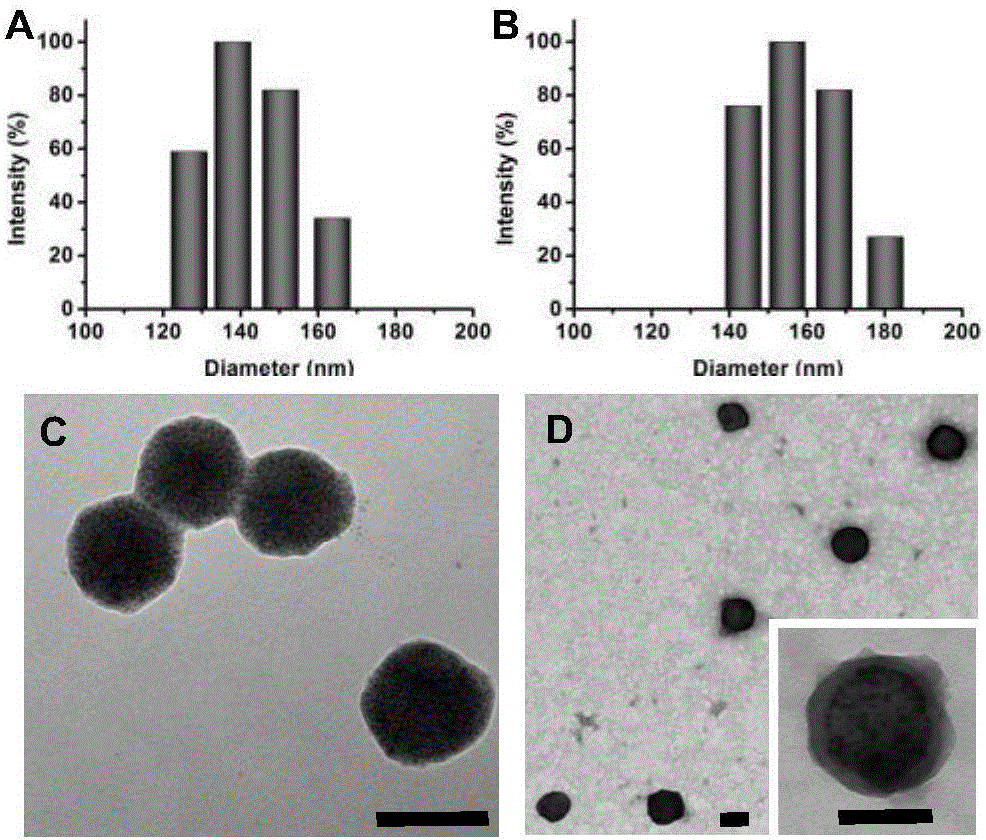Nanometer vesicle capable of simultaneously achieving RNA interference and MR imaging and preparation method and application thereof
A technology of RNA interference and nanovesicles, which is applied in the fields of nanomedicine and biomedical engineering, can solve problems such as limiting repair ability, and achieve the effect of promoting real-time monitoring
- Summary
- Abstract
- Description
- Claims
- Application Information
AI Technical Summary
Problems solved by technology
Method used
Image
Examples
Embodiment 1
[0032] Embodiment 1 Synthesis of amphiphilic block polymer
[0033] (1) Synthesis of linear polyethyleneimine (PEI), the reaction mechanism and process are as follows:
[0034]
[0035] First, poly(2-ethyl-oxazoline) (PEOX) was synthesized by ring-opening polymerization of 2-ethyl-oxazoline. Weigh 0.372g of methyl p-toluenesulfonate (2mmol) into a 50mL three-neck flask, dry in vacuum at room temperature for 2h, add 20mL of freshly steamed acetonitrile to dissolve, then weigh 4.5g of 2-ethyl-oxazoline (45mmol) into the reaction flask Reflux at 80°C for 72 hours; after cooling, immerse the reaction bottle in an ice-water bath, pass through dry ammonia gas (through calcium oxide and sodium hydroxide drying tower) for 1 hour to terminate the polymerization reaction, remove acetonitrile by rotary evaporation, dissolve with chloroform, Reprecipitate in a large amount of ether, centrifuge and dry to obtain pale yellow poly(2-ethyl-oxazoline) (PEOX).
[0036] PEOX can be deprotec...
Embodiment 2
[0044] Example 2 Preparation and Characterization of Nanocomposites
[0045] Get the amphiphilic block polymer prepared in Example 1 to prepare V-SPIO according to the nanocomposite preparation method, such as figure 1 shown. Then, its ability to load siRNA was verified by gel retardation electrophoresis experiment. Specifically, a 1 g / L agarose solution was prepared first, poured into a plate, and then added 1.5 μL ethidium bromide (EB) and stirred evenly. Prepare complex samples according to the N / P ratio of 0.5, 1, 2, 4, 6, 8, and 10. After the gel is completely solidified, pull out the comb, put the gel into the electrophoresis tank, and add the electrophoresis solution to prevent coagulation. Gel, add 2 μL of 50% glycerol to each sample, mix well and add to the sample hole, stop electrophoresis after 40 minutes of constant voltage 100V electrophoresis, take out the gel, put it in a gel imaging system, and observe the electrophoresis strip under ultraviolet light Take an...
Embodiment 3
[0047] Example 3 MRI Detection of Nanoparticle Relaxation Rate
[0048] The water-soluble SPIO, V-SPIO and V-SPIO / siNgR nanoparticles were diluted step by step in a 96-well plate according to the concentration gradient, and the MRI (Philips Inter, 1.5T) in vitro test was performed. MRI scanning parameters are as follows: Fast spin echo T1-weighted image: TR / TE, 500 / 20ms, slice thickness, 1.5mm, FOV, 90×60mm, matrix, 256×256; T2-weighted image: TR / TE, 2600 / 100ms , layer thickness, 1.5mm, FOV, 100×100mm, matrix, 384×256. Obtain the relaxation time of T2. Taking the iron concentration (mM) as the abscissa, the reciprocal of T (r 2 ) is the ordinate, using linear least squares regression analysis, the slope of the line is the relaxation degree of T2. Figure 4 The results showed that after vesicle loading, the T2 relaxation rate was greatly enhanced due to the cluster effect of SPIO, but there was no significant change in the relaxation rate before and after siRNA loading.
PUM
 Login to View More
Login to View More Abstract
Description
Claims
Application Information
 Login to View More
Login to View More - R&D
- Intellectual Property
- Life Sciences
- Materials
- Tech Scout
- Unparalleled Data Quality
- Higher Quality Content
- 60% Fewer Hallucinations
Browse by: Latest US Patents, China's latest patents, Technical Efficacy Thesaurus, Application Domain, Technology Topic, Popular Technical Reports.
© 2025 PatSnap. All rights reserved.Legal|Privacy policy|Modern Slavery Act Transparency Statement|Sitemap|About US| Contact US: help@patsnap.com



